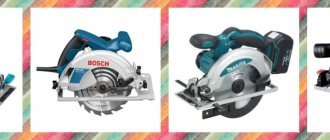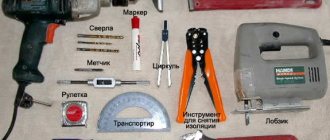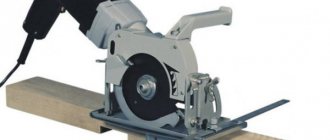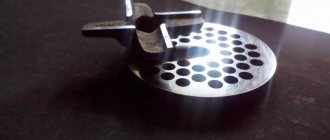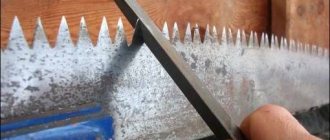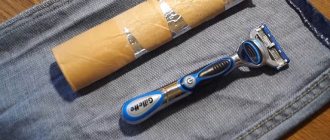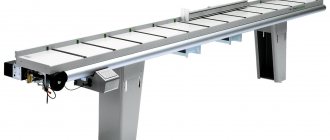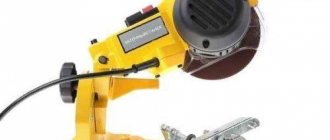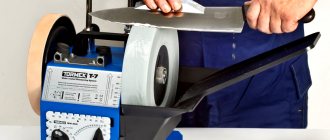Types of discs and teeth, as well as features of their restoration
The teeth of the disk are made of a specialized alloy of tungsten and cobalt (this is evidenced by the markings on the “front” side of the disk - VK, VK6, etc.).
Important! The durability of a disc depends not only on the alloy, but also on the amount and correctness of the work performed.
The tooth has the following geometric planes:
- Front;
- Rear;
- Side – two auxiliary faces.
When geometric planes intersect, two working (cutting) edges arise:
- Home.
- Auxiliary.
Geometric tooth shape:
- Direct . With their help, wooden sheet material is sawn in the longitudinal direction.
- Trapezoidal . This shape ensures long sharpening when working with wood of different hardnesses.
- Beveled . The main or auxiliary edge has an angular bevel, which allows the disk to cut not only into a homogeneous wood structure, but also into laminated chipboards and fiberboards. In addition, the “beveled tooth” can cut plastic.
- Conical . A universal shape that allows for longitudinal and transverse cutting. This form has one drawback, which is the rapid loss of the sharpness of the working edge.
...and keep the knife sharp?
Proven tips will help you in this matter:
- Do not store knives together with other cutlery (forks, spoons, etc.) - the blade will rub against the surface of other objects, microscopic nicks will appear on it, which will dull the blade. The best place for a knife is a wooden stand, a magnetic strip or a special case;
- Don't leave the appliance dirty - it takes a lot of effort to clean dried food. This may scratch the cutting edge of the knife. In addition, many products contain acid, which will lead to metal corrosion;
- Control the duration of contact of the knife blade with water. Lying in a bowl of water for a long time has a bad effect on the metal, as well as the material of the handle;
- To keep your knife sharper longer, wash it only with cold water and try to cut very hot food less often.
What is the difference between turning a stationary machine and a hand-held circular saw?
There is no difference in the teeth that are used on a hand-held circular saw or on a stationary machine - their geometry and production capabilities are identical. There are differences only in the diameter of the circle of the disk itself and its thickness: the dimensions of the disks of stationary circular saws are much larger.
This is explained by the volume of continuous production and the need to cut large-sized wooden material, such as logs and beams. Manual circular saws, in turn, are used to work with finished sheet or other prepared material.
If you do not promptly monitor the sharpness of the incisors (an alternative name for the teeth of the disk), you can reach a condition in which sharpening or restoration will be impossible. This applies equally to stationary and hand saws.
It should be said that stationary saws have specific maintenance and inspection schedules, while hand saws are inspected only at the initiative of the owners.
How to determine the need for sharpening, the degree of wear and decide whether to sharpen or throw away
The working surface of the disk is the teeth-cutters of a certain cutting configuration. Since the disk is a consumable element of the saw, with the amount of work performed, the cutting characteristics of the teeth decrease, and sharpening becomes unsatisfactory.
The following factors indicate that cutters require prompt sharpening:
- It is necessary to increase the pressure of the disk on the surface of the wood to cut and create a cut.
- Smoke appears from under the protective casing and the smell of burning wood is felt.
- The protective cover gets very hot.
- Small sawdust.
Important! The smell of burning indicates that the teeth are not sawing wood, but cutting through it. This leads to an even greater deterioration in the quality of the incisors.
Due to these factors, the following negative consequences occur for a hand-held circular saw:
- Productivity decreases.
- Electricity consumption increases.
- The load on the electric motor and gearbox increases.
This will ultimately lead to device failure.
Sharpening angle for woodworking
The cutters have a working surface that is sharpened at a certain angle. The formation of the angle depends on the material the blade is working with, as well as the performance requirements.
Circular saws are equipped with discs that allow you to cut in one direction or with a reverse movement. For discs with beveled cutters, reverse operation is excluded.
In engineering terminology, the sharpening angle of a cutter is the change in tooth configuration to ensure effective performance when processing wood with the working (cutting) edge of the tooth.
Regardless of how sharpening is performed: manually or on a special machine, the following parameters should be adhered to:
- When cutting wood longitudinally, when its fibers are located lengthwise, a range from 15 to 25 degrees is considered satisfactory.
- For cross cutting, a range of 5 to 10 degrees is relevant.
Important! An angle of 15 degrees is considered universal and is used for any cuts.
In order to effectively sharpen the teeth of circular saw blades, it is necessary to know and take into account another important factor - the density of the surface being processed. Tooth sharpness increases with the softness of the wood and decreases when working with hard wood.
Basic parameters of a circular saw blade
Outer (external) diameter
It is determined by the internal size of the protective casing - a blade with a larger diameter will not fit on a saw with smaller casing dimensions. The main dimensions of cutting tools for hand-held circular saws are in the range of 130-250 mm. The outer diameter does not have a significant effect on the cutting speed, but determines the cutting depth. As the cut increases, the engine is significantly loaded, and the metal of the disk and the workpiece itself are heated.
Internal, landing diameter
It has several sizes: 16, 20, 22, 30, 32. An important parameter is that the diameter must correspond to the size of the power shaft on the saw for which the blade is selected. Some disk models have additional holes that secure the disk to pins.
Number of teeth on the disc
Affects parameters such as cutting speed and processing cleanliness. With a decrease in the number of teeth, the processing speed increases, the conditions for chip removal improve, but the cleanliness of the cut deteriorates. As the number of teeth increases, the cut becomes cleaner, but the load on the engine increases. Conventionally, according to their quantitative ratio, disks can be divided into three groups:
- a large number of incisors, in the range of 80-90 pieces;
- average quantity (40-80 pcs.);
- small quantity (10-40 teeth).
Discs with an average number of cutters are classified as the universal type. They can process soft and hard wood, make transverse and longitudinal cuts, and be used for processing various wood products.
Tooth inclination
Determined by the deviation of the cutting edge surface from the disk radius. When the deviation is towards the back side of the tooth, the inclination is called negative; when the inclination is on the reverse side, it is called positive. For longitudinal sawing, it is more advisable to use a tooth with a positive inclination, since during the processing process a kind of material capture occurs, the disk impacts the part, which contributes to faster cutting of the workpiece as a whole. The inclination of the tooth is divided into:
- standard tilt – the angle varies from 5° to 15°;
- positive, aggressive tilt is 15-20°;
- a typical negative angle ranges from 0° to -5°.
Tooth configuration
Each type of cutter is designed and manufactured to solve a specific task. Subdivided:
- Flat cutter - used for fast longitudinal cutting of soft or hard wood, designated FT.
- Replaceable cutter - has a sequentially alternating, replaceable inclination of the teeth in one direction or the other. The cutters give an even and fairly clean cut. Used for cross and longitudinal cutting of wood, processing plywood, OSB, chipboard and composite boards, indicated by the ATB symbol.
- A combination cutter is a sequential change of groups from a combination of four replaceable cutters (ATB) and one flat cutter (FT). Designated as Combi. This type of disc is considered universal due to its ability to perform different types of cuts.
- Trapezoidal flat cutter - made of successive flat teeth. The higher one is designed as a trapezoid, the lower one is flat. It is used for processing wood and products made from it, for polymer materials and soft non-ferrous metals. Designated TCG.
- Replaceable cutter with large beveled side - designed for processing materials prone to splintering, as well as for finishing crosscuts. Denoted HiATB.
Disc thickness
Determines the actual cutting width. The standard size is 3.2 mm. In addition, the thickness of the disc affects the strength of the cutting tool itself. Reducing the parameter leads to heavy operating conditions, overheating of the disk and failure. A larger size causes increased consumption of the processed material, that is, “translation into chips.”
Circular saws are used in processing various materials. Accordingly, the cutting tool is designed for specific tasks.
Sharpening angles for metal work
Circular saws are used for cutting non-ferrous metals due to the soft texture of the material. The most commonly processed aluminum profile.
Hard metals such as iron and cast iron can only be sawed with a grinder (angle grinder).
To work with metal, discs with a specific tooth configuration and a special sharpening angle are used.
The sharpening angle varies from 30 to 45 degrees, while the cutting edge has a wedge, which cores the metal surface upon initial contact.
Briefly about the main thing
To sharpen a saw intended for sawing wood, it is first clamped in a vice. Then the teeth are set. Then they are leveled in height. Next, take a triangular file and sharpen the prepared teeth with it, first on one and then on the other side of the hacksaw.
When using a grinder, the saw is secured with clamps on a stationary surface. The plane of its canvas should be horizontal relative to the ground. In this case, a disk with a minimum thickness is installed on the grinder. They sharpen saw teeth at an angle of 15-30°.
To cut wood, a classic saw is often used. There are also reward, round, plywood, trigger, two-handled, and axed hacksaws for wood. Each of them consists of a canvas and at least one handle.
Ratings 0
Methods for sharpening a disc for woodworking
The following methods ensure efficient and safe sharpening of circular saws.
Grinder - step by step instructions
Special machines for sharpening circular saw blades are expensive and require certain skills to operate, so angle grinders, that is, “grinders,” are an effective and affordable alternative.
Important! It is strictly forbidden to hold the disc in your hands while sharpening. First of all, it's dangerous; secondly, the required sharpening values will not be achieved.
To fix the disc, a special smooth stand is used, which is designed taking into account the fact that the tooth must be perpendicular to the grinder disc and have a minimum deviation from it.
For sharpening using a grinder, the following algorithm is used:
- The grinder is equipped with a grinding disc, and the disc to be sharpened is attached to the platform.
- The grinder is held by hands or using a holding device.
- The cutting edge of the circular tooth is processed with a grinder. In this case, a light, uniform movement is performed.
Evidence that the edge has been sharpened will be a visual update of the edge - it will no longer be darkened.
It is forbidden to turn on the grinder if the disc is placed in the throat between the teeth of the disc being sharpened.
File
If a file or needle file is used as a tool, then all sharpening activities are the same as when using an angle grinder. In addition, to maintain the sharpening angle, a special template is required, which is used as a guide plane between the tooth and the file.
But at the same time, the work will take much longer, since circular saws use carbide attachments.
Needles are used to “edit” a tooth, that is, to briefly restore the productive geometry of the tooth. During the work process, “editing” requires periodic updating much more often than high-quality sharpening.
Special machine
Machines for turning circular saw cutters are complex engineering and technical devices, which, in addition to mechanisms, are also equipped with automatic electronics.
These machines allow you to perform the most effective restoration of cutting edges in compliance with all the necessary configurations. The efficiency of the machines is explained by the following criteria:
- Possibility of automating the sharpening process.
- Saving sharpening angle parameters for each cutter.
- All cutters are sharpened identically with minimal error.
- Possibility of complete restoration and restoration.
For sharpening on a machine, the saw blade is placed in a special support and secured.
The sharpening parameters are selected, which are provided by special mechanisms for tilting the disc being sharpened or tilting the sharpening disc in the machine.
The disc to be sharpened is placed in the working area of the device.
The machine starts up and sharpening is carried out automatically.
Homemade machine
To operate effectively, homemade machines must include the following components:
- Angle grinder (grinder) as a direct sharpening device.
- Support for securing the saw blade of a circular saw.
- Mechanisms to allow the support to tilt to adjust the sharpening configuration.
- The entire mechanism is fixed to a frame, which can be a channel or an I-beam.
The operating process is similar to using the original sharpening machine with the only difference - the circular blade is fed to the working area of the device manually.
In what cases is it better to take it to a workshop?
It is best to take the disk to a repair shop for restoration in the following cases:
- Cascading change in tooth configuration, that is, the teeth have different cutting edge angles. This phenomenon occurs if the nozzle is “walked” over a stone.
- Bevel or bend of a cutter.
- Chipping of the cutter.
- Wear of the pobedite tip on the cutter.
If the disc itself is cracked or bent, it is best to recycle it.
How to sharpen a circular saw with pobedit tips with your own hands
Due to their high strength and hardness, pobedit-tipped cutters can only be sharpened with diamond-coated attachments.
Important! Methods of sharpening a circular saw blade using a grinder (also known as an angle grinder) or files are excluded, since pobedite soldering does not tolerate even the slightest deviation in tooth geometry.
The diamond disk of the machine must adhere evenly and over the entire surface to the cutter. Maintaining a uniform sharpening angle is also mandatory. These requirements are achievable only when using special sharpening devices.
Inexpensive machines from 5 to 30 thousand rubles
The category of inexpensive machines for sharpening circular saws includes both lightweight, small-sized devices with a simplified design and low drive power, as well as popular full-featured models. All of them are Russian brands made in China, and generally have good reviews. The JMY 8-70 machine is also sold in Russia under the indexes MTY 8-70 and LTT JMY 8-70.
| № | Model | Max. diameter (mm) | Drive Power (W) | Weight, kg) | Control type | Price, rub.) |
| 1 | "Caliber Master" EZS-110 Dm | 400 | 110 | 2,4 | manual | 6 000 |
| 2 | EINHELL BT-SH 90/350 | 350 | 110 | 5,7 | manual | 6 500 |
| 3 | JMY 8-70 | 550 | 250 | 42 | manual | 18 000 |
| 4 | "Kraton" SBS-600 | 600 | 370 | 54 | manual | 25 000 |
| 5 | "Anchor Corvette" 472 | 600 | 370 | 45 | manual | 27 000 |
How to make a homemade sharpening device?
As instructions for the manufacture of a device for sharpening circular saws, we will present a list of structural elements, drawings with their placement and regular place in the device.
The device must include the following structural elements.
- An electric motor that is mounted on a stand so that a grinding disc can be mounted on its shaft (an alternative is an angle grinder).
- A stand that allows you to feed the cutters to the grinding surface in one plane and on the same axis.
- Adjusting screws to equip the platform with the ability to change the parameters of the angle of inclination in the vertical and horizontal axes.
- Clamps for securing the circular blade and the platform on which it is placed.
- Device for feeding the engine back and forth.
- Protective casing for rotating engine elements.
The article examined everything that could be useful for sharpening a circular saw blade; this data is quite enough to carry out the procedure with your own hands and get a good result. If you are confident in your abilities, then go ahead, try, sharpen, it is advisable to practice on an old disk for the first time. Otherwise, contact a workshop, they will sharpen the disc quickly and efficiently, using special equipment, for a reasonable fee.
Types of machines
It is almost impossible to sharpen a circular saw blade without special equipment. In order to significantly simplify the task, special machines have been created that allow you to sharpen disks of almost any configuration in the shortest possible time. The main classification of the proposed equipment is as follows:
- Models for home use. This type of design is easier to use, but has lower productivity. By simplifying the machine and reducing its productivity, the cost is also reduced. However, you may encounter a situation where a sharpening device for use at home has a shorter service life.
- Machines for professional use are highly productive and reliable, but they may be difficult to install at home. In addition, the cost of equipment increases significantly by increasing its performance, reliability and versatility.
The type of machine intended for domestic use can operate for no more than 20 minutes. After passing this time period, you should turn off the equipment and allow it to cool. Models intended for professional use can work for several hours.
Particular attention should be paid to the equipment of the equipment in question. According to this indicator there are:
- Equipment with abrasive grinding wheels.
- Models with sanding belt.
Let's consider the classic layout of the machine, since a hacksaw or other hand tool does not give the desired result.
